Famous diaries offer a unique glimpse into the past. They bring personal thoughts and extraordinary moments to life. These historical journals capture our imagination with intimate views of heartbreaking and inspiring worlds.
Notable diarists have documented remarkable experiences throughout history. Anne Frank’s poignant Holocaust survival record stands out. Samuel Pepys’ vivid accounts of 17th-century London also provide valuable insights.
These diaries are powerful testimonies of the human spirit. They reveal emotions, struggles, and triumphs often missed in textbooks. Each journal offers a unique perspective on challenging times.
Personal writings can transform our understanding of history. They bridge the gap between past and present. These accounts connect us with extraordinary individuals who witnessed pivotal moments.
Introduction to Famous Diaries
Personal diaries offer a unique glimpse into the past. They reveal intimate perspectives often missed in traditional historical records. These writings provide a personal lens to understand significant moments in history.
Diaries are more than daily recordings. They are cultural artifacts capturing individual experiences across different times. From wartime journals to scientific notebooks, these accounts create a rich tapestry of human understanding.
“A diary is a precise record of one’s inner life, as seen through the eyes of lived experience.” – Anonymous
Famous diary examples reveal several key insights:
- Diaries capture raw, unfiltered emotions and thoughts
- They provide firsthand accounts of historical events
- Personal writings offer unique psychological perspectives
- They document social and cultural transformations
Diaries are more than personal memories. They serve as critical primary sources for historians, researchers, and scholars. These writings help us understand nuanced human experiences throughout history.
Diaries document scientific discoveries, personal struggles, and momentous events. They continue to be invaluable resources bridging our understanding between past and present.
The Diary of Anne Frank
Anne Frank’s diary is a powerful testament to the human spirit. It captures survival, hope, and resilience during the Holocaust. Her writing has transformed our understanding of this dark period in history.
Anne received the diary on her 13th birthday in June 1942. It soon became an extraordinary cultural influence. Her words continue to educate and inspire generations.
Historical Context and Significance
Anne began writing while hiding in a secret Amsterdam annex. Her diary covers June 1942 to August 1944. It documents the experiences of eight people hiding during World War II.
- Documented life in hiding during Nazi occupation
- Captured the emotional journey of a young girl
- Provided intimate insights into Holocaust experiences
Key Themes and Impact
Anne’s narrative highlights the importance of writing. Her diary reveals profound observations about human nature and family dynamics. It also shows her personal growth during this challenging time.
The manuscript spans three volumes. Each reveals different stages of her remarkable journey. Her words continue to resonate with readers worldwide.
“I keep my ideals, because in spite of everything I still believe that people are really good at heart.”
| Diary Publication Details | Key Information |
|---|---|
| First Published | 25 June 1947 (Dutch Edition) |
| Languages Translated | Over 70 languages |
| English Translation | Published in 1952 |
| Surviving Family Member | Otto Frank (her father) |
Anne’s diary is more than a historical document. It’s a profound symbol of hope and human resilience. Otto Frank, Anne’s father, was the only family member to survive.
He ensured his daughter’s legacy would live on. Thanks to him, Anne’s words continue to touch hearts around the world.
The Diaries of Samuel Pepys
Samuel Pepys created an extraordinary chronicle of 17th-century life. His famous journal offers a unique glimpse into England’s Restoration era. Historians and readers alike are still captivated by his remarkable historical diary.
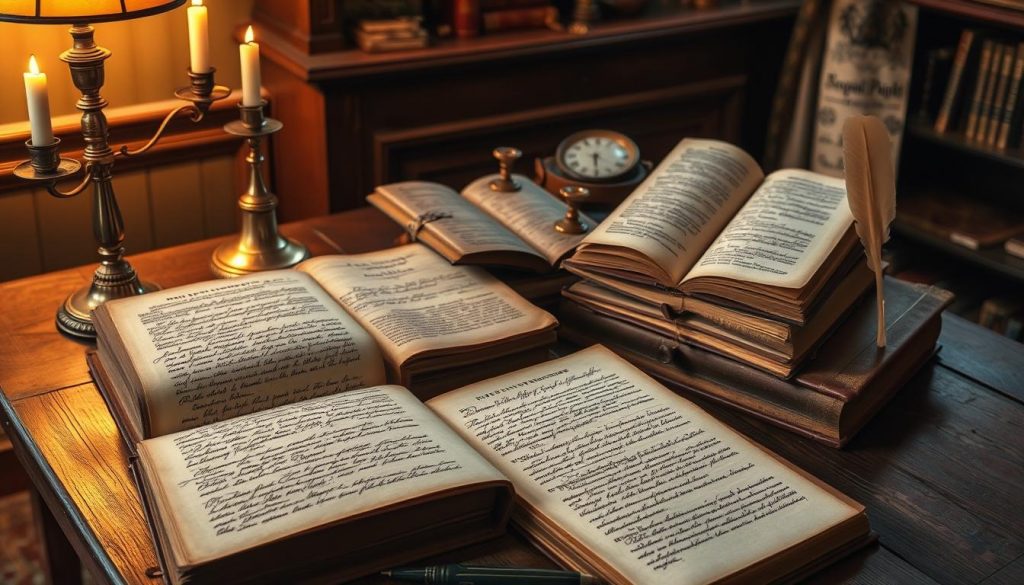
Pepys started his diary on January 1, 1660, and wrote for nearly a decade. These historical diaries span an incredible one million words. They capture intricate details of daily life during a turbulent time.
Insights into 17th-Century Life
His diary paints a rich picture of Restoration England through personal observations. Pepys wrote about many aspects of life.
- Intimate family interactions
- Social gatherings and theatrical performances
- Political discussions and office politics
- Personal financial transactions
Notable Events Recorded
Pepys witnessed some of London’s most significant events. His diary provides first-hand accounts of major happenings.
- The Great Plague of London (1665)
- The Great Fire of London (1666)
- Complex political landscape of the Restoration period
“To see how a man’s life is run by chance!” – Samuel Pepys
These journals offer more than historical facts. They show a man navigating 17th-century England’s complex social world. Pepys recorded both work discussions and personal moments.
His diary remains an invaluable record of history. It continues to fascinate researchers and readers today.
Virginia Woolf’s “A Writer’s Diary”
Virginia Woolf’s “A Writer’s Diary” offers a glimpse into a literary genius’s mind. This personal journal reveals the creative process of a 20th-century writing icon. It stands as a profound example of well-known personal journals.
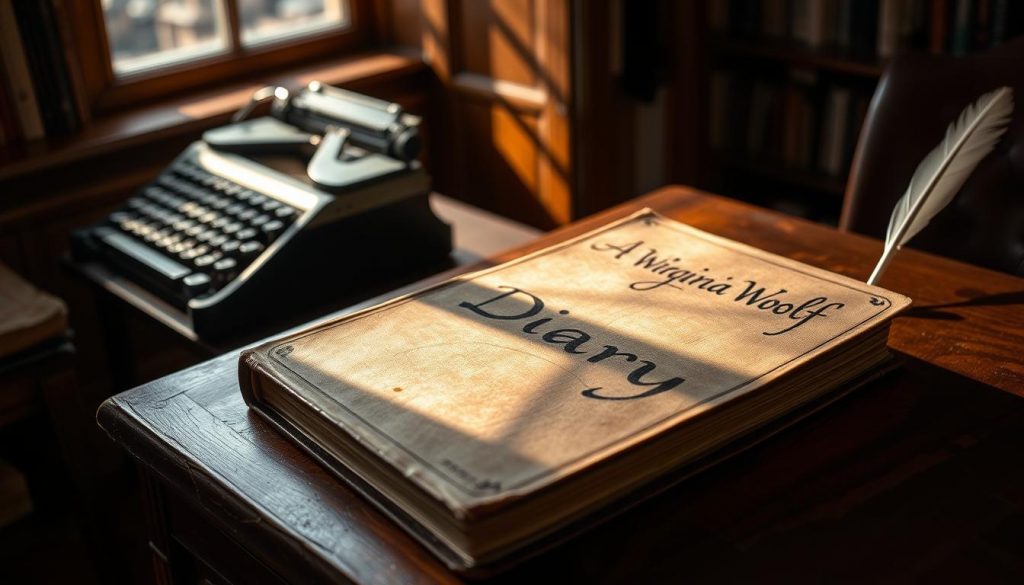
The Evolution of a Literary Mind
Woolf’s diary spans 27 years, from 1915 to 1941. It captures her intellectual journey with remarkable depth. The journal documents her writing experiences and vulnerabilities.
- Began journaling in 1918 at age 36
- Continued until three weeks before her death in 1941
- Recorded interactions with literary figures like E.M. Forster and Thomas Hardy
Reflections on Writing and Creativity
Woolf’s journal reveals her most intimate thoughts about writing. She candidly shared her creative struggles, mental health challenges, and artistic breakthroughs.
“I can only note that the past is beautiful because one never realises an emotion at the time. It expands later, and thus we don’t have complete emotions about the present, only about the past.” – Virginia Woolf
The diary offers a unique view into her creative process. It shows how she developed groundbreaking novels like “Night and Day”. Her final work, “Between the Acts”, is also included.
This collection contains 368 pages of raw, unfiltered thoughts. It provides an unmatched look into the mind of a literary icon.
Woolf’s diary will inspire writers, literature fans, and curious minds alike. It offers a rare chance to explore the inner workings of brilliance.
The Diary of a Young Girl by Anne Frank
Anne Frank’s diary is a powerful historical journal from the 20th century. It shows human resilience during a dark time in history. Her personal account of the Holocaust still moves readers worldwide.
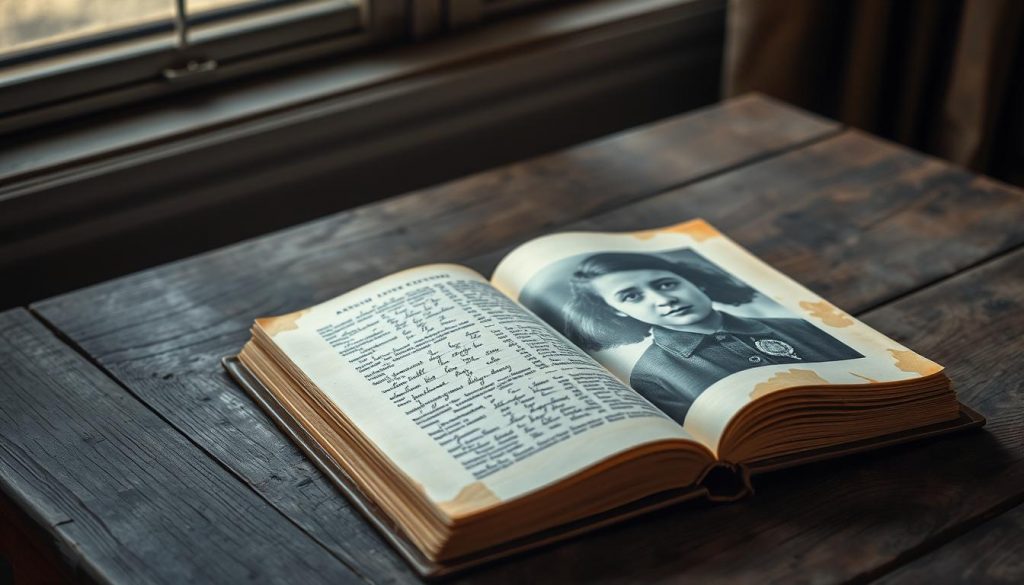
The Story Behind the Diary
Anne got a red-checked diary for her 13th birthday. It became her closest companion during their hidden years. From July 1942 to August 1944, she wrote about life in the Secret Annex.
- Received diary on June 12, 1942
- Went into hiding on July 6, 1942
- Hidden with seven other people
- Discovered by Gestapo on August 4, 1944
Cultural Impact and Educational Significance
The diary’s impact goes beyond its first printing. It’s now in over 65 languages and teaches many about the Holocaust. Despite some school bans, it keeps inspiring new generations.
“I keep my ideals, because in spite of everything I still believe that people are really good at heart.” – Anne Frank
| Publication Details | Key Information |
|---|---|
| First Dutch Publication | June 25, 1947 |
| First American Edition | 1952 |
| Languages Translated | 65+ |
| Survivors from Secret Annex | 1 (Otto Frank) |
Anne Frank’s diary shows the strength of the human spirit. It turned a personal story into a universal message. Her words still teach and inspire, making this diary a lasting symbol of hope.
The Journals of Lewis and Clark
Lewis and Clark’s historical diaries document a remarkable exploration of the American wilderness. Their journals record an incredible journey of discovery and adventure. These writings are an invaluable part of United States history.
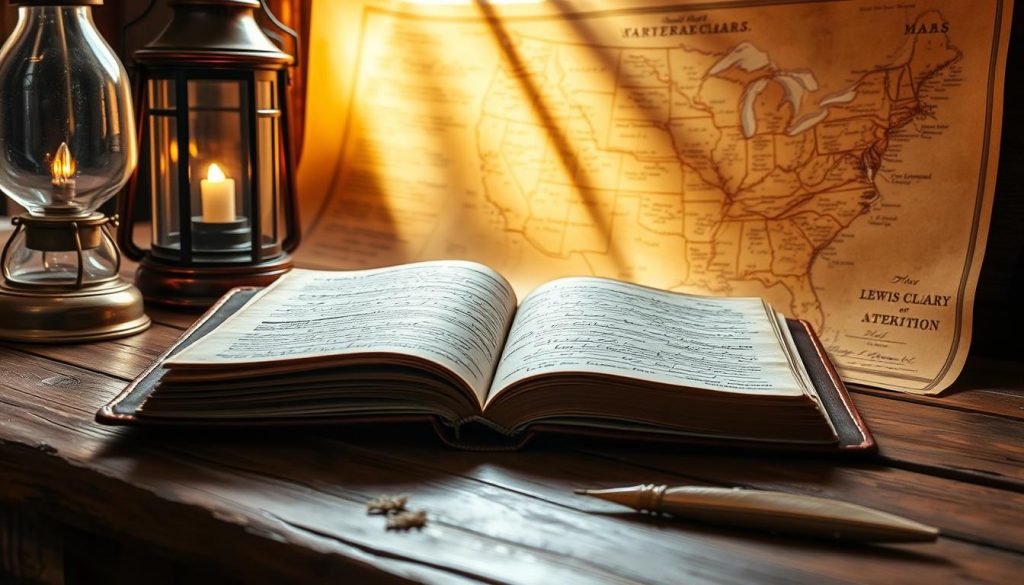
The expedition covered 8,000 miles of uncharted North American territories. It lasted from May 1804 to September 1806. Lewis and Clark led a team of about 40 people through unexplored landscapes.
Exploration and Discovery
Their journals are filled with scientific and cultural insights. These historical diaries captured details about:
- New plant and animal species
- Geological observations
- Weather patterns
- Native American cultures
The Significance of Their Journey
The expedition’s documentation was revolutionary. Their 18 small notebooks contained detailed observations. These insights reshaped American scientific understanding.
“We were now about to penetrate a country at least two thousand miles in width, on which the foot of civilized man had never trodden.” – Meriwether Lewis
| Expedition Details | Statistics |
|---|---|
| Duration | 28 months |
| Distance Traveled | 8,000 miles |
| Team Size | Approximately 40 members |
| Journals | 18 notebooks (13 in red morocco leather) |
The Lewis and Clark journals changed our view of the American West. Their work influenced future expeditions and settlement patterns. Their legacy continues to shape our understanding of early America.
The Diary of Elizabeth Cady Stanton
Elizabeth Cady Stanton was a key figure in 19th-century journal writing. Her autobiographical works captured the women’s rights movement during a transformative period in America.
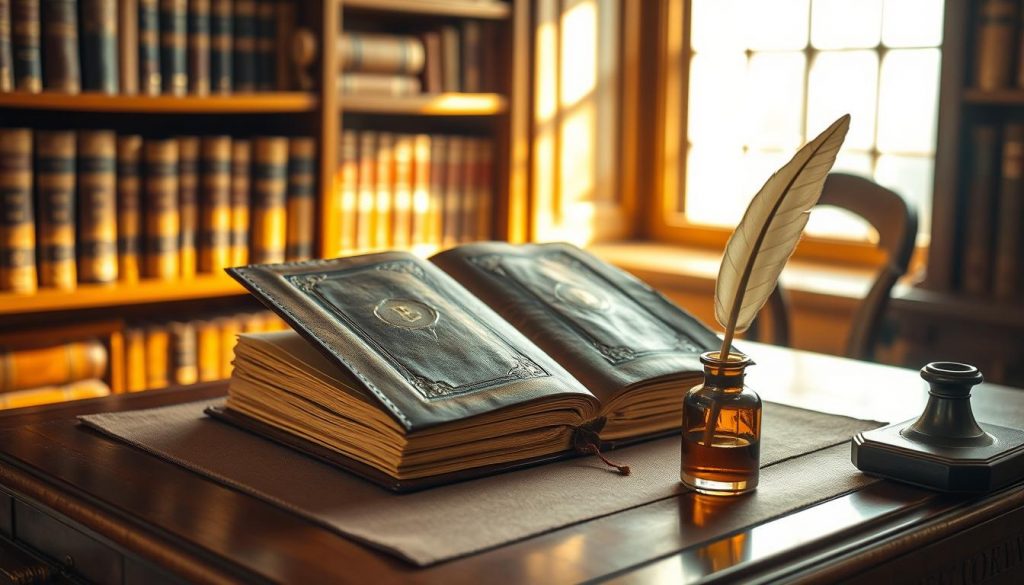
Stanton’s writings offer unique insights into early feminist activism. Her collection spans 132 years, from 1814 to 1946. It contains about 1,000 items and 4,164 images.
These documents showcase her lifelong fight for women’s equality. They highlight her unwavering commitment to this cause.
Women’s Rights Advocacy Through Personal Writings
Her diaries reveal crucial moments in the women’s rights movement. They include key events like the 1848 Seneca Falls Convention.
The collection features several important documents. These include:
- Declaration of Sentiments
- Drafts of “Eighty Years and More”
- Controversial “The Woman’s Bible” (1895)
Influential Ideas and Personal Reflections
“The true woman will not be exponent of another’s thought or fashion, but will evolve her own.”
Stanton’s writings show her diverse approach to social change. She challenged gender norms through her passionate accounts. Her focus was on women’s education and voting rights.
| Collection Highlight | Details |
|---|---|
| Collection Period | 1814-1946 |
| Total Items | Approximately 1,000 |
| Key Correspondents | Susan B. Anthony, Frederick Douglass |
Stanton’s impact goes beyond her personal journals. Her writing became a powerful tool for advancing women’s rights. She inspired generations of activists to challenge societal limits.
The Journals of Sylvia Plath
Sylvia Plath’s journals are powerful examples of famous diaries. They offer deep insights into a writer’s inner world. Her detailed records show how writing can help us understand ourselves better.
Plath’s journals give us a raw look into her life. They’ve been published in different versions over the years. The first release was in 1982, with an unabridged version in 2000.
Ted Hughes, Plath’s husband, destroyed her final journals. This act caused much debate among literary scholars.
Exploring Mental Health and Identity
Plath’s journals show deep thoughts on mental health and personal identity. Her writings capture:
- Intense emotional experiences
- Struggles with societal expectations
- Creative challenges and breakthroughs
Impact on Modern Literature
“I write only because there is a voice within me that will not be still.” – Sylvia Plath
A close look at her journals reveals interesting facts:
| Journal Characteristic | Frequency |
|---|---|
| Emotional Themes | Prevalent in 6 out of 9 excerpts |
| Cultural References | 2 musical artists mentioned |
| Detailed Descriptions | Over 10 sensory details |
Her journals continue to inspire many writers and readers. They show how powerful personal writing can be for both literature and self-help.
Frank Lloyd Wright’s “An Autobiography”
Frank Lloyd Wright’s autobiography offers a peek into a creative genius’s mind. Published in 1943, it reveals the thoughts of America’s most influential architect. This remarkable diary revolutionized architectural design.
Wright’s autobiography showcases his philosophical approach to architecture and life. Born 152 years ago, he left an enduring impact on American design. His work continues to inspire architects and designers today.
Architectural Innovations and Philosophies
Wright’s architectural vision extended beyond traditional building design. His unique approach transformed the field.
- Developing the Prairie School architectural style
- Creating Usonian houses for middle-class Americans
- Designing iconic structures like the Guggenheim Museum
- Integrating buildings harmoniously with their natural surroundings
“The longer I live, the more beautiful life becomes.” – Frank Lloyd Wright
Personal Reflections on Success
The autobiography’s cultural impact reaches beyond architecture. Wright openly shared his personal struggles and relationships. He also discussed the philosophical beliefs that shaped his extraordinary career.
| Key Architectural Achievements | Year |
|---|---|
| Larkin Company Administration Building | 1906 |
| Unity Temple | 1906 |
| Imperial Hotel (Tokyo) | 1922 |
| Guggenheim Museum | 1959 |
Wright’s autobiography is more than a professional memoir. It’s a testament to creativity and perseverance. The book showcases the power of innovative thinking, inspiring generations.
The Diary of a Former Slave
Historical journals of enslaved individuals reveal a crucial part of American history. These autobiographical treasures offer unique insights into experiences during one of our nation’s most challenging times. They provide a window into the lives of those who endured slavery.
The Federal Writers’ Project preserved these vital first-person accounts from 1936 to 1938. Researchers gathered over 2,300 personal narratives from former slaves. These stories captured their experiences before and after emancipation.
Documenting Life Before Freedom
These historical journals offer an unfiltered view of slavery’s harsh realities. The project’s impact goes beyond simple documentation.
- Preserved over 500 black-and-white photographs of former slaves
- Compiled narratives into seventeen comprehensive volumes
- Digitized materials in 2000-2001 with significant funding
- Captured stories from seventeen different states
The Importance of First-Person Accounts
These diaries have had a profound cultural influence. They changed historical understanding by providing direct testimonies from those who experienced slavery firsthand.
“Our stories are our strength, our resistance, our hope.” – Anonymous Slave Narrative Contributor
The project’s collection method was thorough and organized. Narratives were arranged alphabetically by state and informant’s surname. This approach ensured systematic preservation of these crucial historical documents.
| Project Details | Statistics |
|---|---|
| Total Narratives Collected | 2,300+ |
| Photographs Preserved | 500 |
| States Involved | 17 |
| Publication Year | 1941 |
These powerful narratives continue to educate and inspire readers today. They ensure that the experiences of enslaved individuals are remembered and honored for generations to come.
Historic Diaries from World War II
World War II was a pivotal moment in human history. Personal diaries offer unique insights into this global conflict. They capture raw emotions, struggles, and experiences of individuals during this challenging period.
Personal accounts from the war front reveal extraordinary stories. They showcase survival, courage, and human resilience. These diaries provide a unique window into the lives of soldiers and civilians.
Voices from the War Front
Several remarkable diaries stand out for their cultural impact and historical significance:
- Anne Frank’s diary, begun at age 13, documents her family’s hidden life in Nazi-occupied Amsterdam
- Victor Klemperer’s diaries, published in 1995, detail the experiences of Jews under Nazi policies
- George S. Patton’s personal writings, which later formed the basis of his memoir War as I Knew It
Impact on Historical Narratives
“In war, there are no unwounded soldiers.” – José Narosky
These personal accounts have changed our understanding of World War II. Some notable statistics highlight the depth of documentary evidence:
- Total stories in the WW2 People’s War archive: 47,000
- Number of individually contributed diaries: 153
- Highest number of stories in a single diary: 44
These historical diaries show the power of personal narratives. They help preserve and understand complex historical moments. Behind every statistic, there are individual human stories of hope, tragedy, and resilience.
The Role of Personal Diaries in Historical Research
Historical journals offer a unique view into the past. They provide intimate glimpses of human experiences often missed by traditional records. Personal diaries breathe life into historical narratives, capturing nuanced details of everyday existence.
Writing personal journals goes beyond simple record-keeping. These documents reveal complex social dynamics and individual perspectives. They also capture cultural nuances that official documents often miss.
How Diaries Add Richness to History
Diaries provide researchers with valuable insights into historical periods. They offer authentic personal experiences and detailed observations of daily life. These journals also reveal emotional contexts of historical events and unfiltered perspectives from ordinary people.
- Authentic personal experiences
- Detailed observations of daily life
- Emotional contexts of historical events
- Unfiltered perspectives from ordinary people
“Diaries are windows into the soul of an era, revealing truths that official records cannot.” – Historical Research Journal
Using Diaries as Primary Sources
Researchers must critically analyze famous journal examples. The sixteenth century marked the start of modern diary writing. This period saw significant developments in documentation techniques.
Using diaries in historical research requires careful consideration. Researchers must verify the document’s authenticity and understand the author’s potential biases. They should also contextualize the diary within its historical period and cross-reference with other sources.
- Verifying the document’s authenticity
- Understanding the author’s potential biases
- Contextualizing the diary within its historical period
- Cross-referencing with other historical sources
Diaries transform historical research from a collection of facts to a rich, human narrative. They connect us directly with past experiences, bringing history to life.
Conclusion: Why Famous Diaries Matter
Famous diaries offer unique insights into personal experiences across history. They reveal human resilience and emotion that textbooks often miss. Anne Frank’s writings and other notable journals showcase this power.
Personal diaries preserve individual perspectives, building a rich tapestry of human history. These intimate accounts provide unique insights into complex social experiences. They document life during wartime and explore personal growth.
Reflecting on Personal and Collective Histories
Your story matters too. Your personal diary could become valuable for future generations. Writing allows you to explore thoughts and process experiences.
It creates a lasting personal archive that captures life’s nuances. Historians study famous diaries to understand broader cultural contexts.
Encouragement to Start Your Own Diary
Begin documenting your journey today. Write about daily experiences, challenges, or moments of joy. Your diary can become a powerful tool for self-reflection.
It also serves as historical documentation. The most remarkable diaries often start with simple, honest observations. Record life as you experience it right now.
FAQ
What makes a diary historically significant?
Historically significant diaries offer unique insights into specific time periods and personal experiences. They provide unfiltered perspectives on events, emotions, and daily life. These documents are invaluable for understanding human history in ways official records often miss.
Why is Anne Frank’s diary so important?
Anne Frank’s diary is a powerful Holocaust testimony that humanizes the experience of persecution. It offers a personal account of survival and hope during a dark period in history. The diary provides an intimate view of life under Nazi occupation, educating millions about war’s human cost.
How do personal diaries contribute to historical research?
Personal diaries serve as primary sources, offering ground-level perspectives on historical events. They reveal social norms, emotions, and daily experiences often overlooked in traditional documents. These insights help researchers develop a more comprehensive understanding of past societies and individual experiences.
What are some characteristics of famous historical diaries?
Famous historical diaries share key traits: authenticity, detailed observations, and historical context. They capture personal struggles, societal challenges, and unique perspectives on specific time periods. These diaries often provide emotional depth and insights that go beyond traditional historical narratives.
How can keeping a personal diary be meaningful?
Keeping a diary provides space for self-reflection and documents personal growth. It can be a therapeutic tool and creative outlet. Diaries also create a historical record of your life for future generations.
Are digital journals as valuable as traditional handwritten diaries?
Digital journals can be equally valuable, offering benefits like easy preservation and searchability. They can include multimedia elements, enhancing the documentation process. While the medium has changed, digital journals still serve the core purpose of recording personal experiences.
What challenges do historians face when using diaries as sources?
Historians must carefully evaluate diary sources for biases, authenticity, and contextual limitations. Personal perspectives might not represent broader experiences. Potential self-censorship is another challenge. Cross-referencing with other historical evidence is necessary to ensure accurate interpretation.
How have famous diaries influenced literature and culture?
Famous diaries have greatly impacted literature and culture by providing raw, unfiltered narratives. They’ve inspired writers, historians, and readers alike. These diaries have sparked conversations about social issues and humanized historical events. They demonstrate the power of personal storytelling in understanding complex human experiences.
Source Links
- History’s greatest diaries
- Historical Diaries and Journals as a People’s History
- History of reading tutorial 1: Finding evidence of reading in the past
- Holocaust diaries by Anne Frank and other young writers
- Dear Diary: 7 Famous People Who Kept Journals
- The Diary of a Young Girl
- The two versions of Anne’s diary
- Diary, Letters, Family Tree, Maps, Encyclopedia, Discussion and more
- Samuel Pepys
- The Diary of Samuel Pepys
- A Writer’s Diary: Being extracts from the diary of Virginia Woolf – Leonard Woolf (Ed. 1953)
- A Writer’s Diary
- Amazon.com: A Writer's Diary: 9780156027915: Woolf, Virginia: Books
- The Diary of a Young Girl
- Diary of a Young Girl | Anne Frank, History, & Facts | Britannica
- The journals of Lewis and Clark
- The Journals of Lewis and Clark
- About this Collection | Elizabeth Cady Stanton Papers | Digital Collections | Library of Congress
- The lost diaries of Elizabeth Cady Stanton, by Sarah Bates
- About this Collection | Susan B. Anthony Papers | Digital Collections | Library of Congress
- Did you know… Sylvia Plath’s Diaries at the Lilly Library
- The Books: The Unabridged Journals of Sylvia Plath
- The Journals of Sylvia Plath: part two
- What We’re Reading: Finding the Wright Book on Frank Lloyd Wright
- Full text of “Frank Lloyd Wright An Autobiography”
- About this Collection | Born in Slavery: Slave Narratives from the Federal Writers’ Project, 1936-1938 | Digital Collections | Library of Congress
- Massachusetts Historical Society: Object of the Month
- Finding fortitude from the diaries of a man who escaped slavery
- 12 World War II Diaries You Can Read
- BBC – WW2 People’s War – Archive List
- Diaries as historical sources – Unique and Distinctive
- Understanding Sources: diaries
- What Kind of Historical Source are Letters and Diaries?
- Diaries as Historical Sources Lesson
- The Significance of Leonard Arrington’s Diaries
- Diaries as a Methodological Innovation for Studying Grand Challenges
